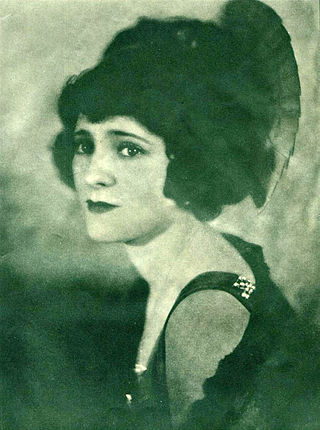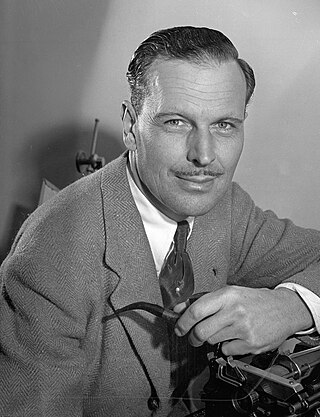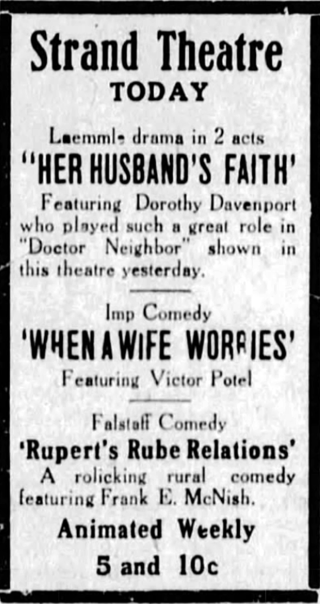This article needs additional citations for verification .(April 2008) |
Gloria Fonda (1896 - January 20, 1978) was a U.S. actress of the silent film era. She was from St. Paul, Minnesota.
This article needs additional citations for verification .(April 2008) |
Gloria Fonda (1896 - January 20, 1978) was a U.S. actress of the silent film era. She was from St. Paul, Minnesota.
Fonda's father was a glove manufacturer in Seattle. [1] While she was a student at the University of Washington, she won a beauty contest, and in 1917 she was one of two winners in the International Beauty Contest held in the United States. [2]
Fonda won a most beautiful girl in Washington pageant sponsored by Universal Pictures. Her home was in Seattle, Washington. She came to Hollywood with sixty other beauties from American states.
Fonda made only seven films during a career which lasted from 1915–1916. Often she appeared in movies directed by William C. Dowlan. Among these are The Mayor's Decision (1915), The Devil and Idle Hands (1915), and Drugged Waters (1916).
She played the role of Gladys Saunders in the latter, her final film. Released by Red Feather Productions, the drama concerned a health resort and a spring of water which was pure. The water was drugged daily in order to deceive wealthy people who came to the spa to restore their health. The Mayor's Decision was a short drama of politics, slum life, and double intrigue. It was a Universal and Carl Laemmle production.
Dowlan directed Fonda in a Laemmle single reel picture entitled The Great Fear (1915). Dowlan co-starred along with Lula Warrenton.
In 1919-1921 Fonda performed on stage in the Orient. [3]

Alice Brady was an American actress of stage and film. She began her career in the theatre in 1911, and her first important success came on Broadway in 1912 when she created the role of Meg March in the original production of Marian de Forest's Little Women. As a screen actress she first appeared in silent films and was one of the few actresses to survive the transition into talkies. She worked until six months before her death from cancer in 1939. Her films include My Man Godfrey (1936), in which she plays the flighty mother of Carole Lombard's character, and In Old Chicago (1937) for which she won the Academy Award for Best Supporting Actress.

Ruth Roland was an American stage and film actress and film producer.

Grace Cunard was an American actress, screenwriter and film director. During the silent era, she starred in over 100 films, wrote or co-wrote at least 44 of those productions, and directed no fewer than eight of them. In addition, she edited many of her films, including some of the shorts, serials, and features she developed in collaboration with Francis Ford. Her younger sister, Mina Cunard, was also a film actress.

John Hartford Hoxie was an American rodeo performer and motion-picture actor whose career was most prominent in the silent film era of the 1910s through the 1930s. Hoxie is best recalled for his roles in Westerns and rarely strayed from the genre.

Violet Mersereau was an American stage and film actress. Over the course of her screen career, Mersereau appeared in over 100 short and silent film features.

Edith Roberts was an American silent film actress from New York City.

William C. Dowlan was an American stage performer and a film actor and director during the silent era. Most of his directorial projects were done in collaboration with his wife, screenwriter Leonora Ainsworth. Between 1915 and 1917 he and Ainsworth did extensive work together for Universal Film Manufacturing Company in Los Angeles and for the American Film Company at its facilities in Santa Barbara.
Leonora Ainsworth was an American "scenarist" or screenwriter for studio films produced at various locations in California during the silent era.

Fay Tincher was an American comic actress in motion pictures of the silent film era.

Ella Augusta Hall was an American actress. She appeared in more than 90 films between 1912 and 1933.

Agnes Vernon was an American film actress of the silent era. While still in her teens, she experienced a meteoric ascent from obscurity to box-office sensation. After turning twenty-three and a movie career fading away, she abandoned the silver screen forever. Vernon performed in over 90 films between 1913 and 1922. She completed most of her roles under contract with Universal Pictures.

Alfred Emory Johnson was an American actor, director, producer, and writer. As a teenager, he started acting in silent films. Early in his career, Carl Laemmle chose Emory to become a Universal Studio leading man. He also became part of one of the early Hollywood celebrity marriages when he wed Ella Hall.

Barriers of Society is a 1916 American silent drama film directed by Lloyd B. Carleton. Universal based the film on the story written by Clarke Irvine and adapted for the screen by Fred Myton. The feature film stars Dorothy Davenport, Emory Johnson, and an all-star cast of Universal contract players.

Her Husband's Faith is a 1916 American silent short film directed by Lloyd B. Carleton. The film is based on a story by Paul Machette. Eugene De Rue developed the screenplay. This domestic society drama's features Dorothy Davenport, T. D. Crittenden and Emory Johnson.

Heartaches is a 1916 American silent short film directed by Lloyd B. Carleton. The film is based on a story by Grant Carpenter. This drama's features Dorothy Davenport, Alfred Allen, and Emory Johnson.

Her Soul's Song is a 1916 American silent short film directed by Lloyd B. Carleton. The film is based on a story by Betty Schade. Calder Johnstone developed the screenplay. This drama's features Dorothy Davenport and Emory Johnson.

The Human Gamble was a 1916 American silent Short film directed by Lloyd B. Carleton. The film is based on the story and screen adaptation by Calder Johnstone. The drama stars Dorothy Davenport, Emory Johnson, and a cast of Universal contract players.

No. 16 Martin Street was a 1916 American silent Short film directed by Lloyd B. Carleton. The film was based on the detective story and screen adaptation by Bess Meredyth. The drama stars Dorothy Davenport, Emory Johnson, and an all-star cast of Universal contract players.

Frances White was an American singer and actress on Broadway, on the vaudeville stage, and in silent films. She popularized the spelling song "M-I-S-S-I-S-S-I-P-P-I". She played "Fanny Warden" in The New Adventures of J. Rufus Wallingford (1915), a series of silent short comedies. She was also in the cast of the eugenics film The Black Stork (1917).

Universal City Zoo was a private animal collection in southern California that provided animals for silent-era Universal Pictures adventure films, circus pictures, and animal comedies, and to "serve as a point of interest" for tourists visiting Universal City. The animals were also leased to other studios. The zoo was closed in 1930, after cinema's transition to synchronized sound complicated the existing systems for using trained animals onscreen.